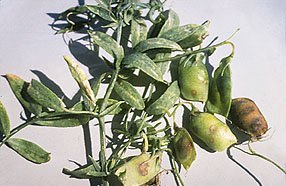Ascochyta in Lentils
Ascochyta blight is a widespread disease of lentils. The lesions reduce yield by weakening the plant. If the disease hits early, the flowers will drop off before the pods can be produced, further reducing the yield. It also stains the seed, resulting in downgrading or rejection.

Host Crops
Lentils
Biology
The spores overwinter on crop residues and do not survive in soil. The disease is carried on the seed or infected stubble. Ascochyta spores, formed in fruiting bodies on infected crop debris, can be spread by wind to neighbouring fields. Later in the summer and within fields, it is mainly spread by splashing rain. Infected plants produce infected seed and stubble. Wet weather in late summer can result in extensive pod and seed infection.
Symptoms Of Damage
Light-grey to tan coloured spots and lesions appear on the leaves, pods, and stems. The leaf spots are usually white to purplish in colour. They have indefinite margins and are round to irregular shape. The lesions have a dark- brown margin. The stem lesions are long and purple. Later, tiny black pepper- like spots appear in the centre of the lesions. These are the fruiting bodies of the disease.
Scouting Techniques
In wet weather, the lesions may coalesce, resulting in premature leaf drop and defoliation. The tips of severely-diseased stems wilt, turn brown, and die. The crop looks blighted. Later in the season, lesions may form on the pods, infecting the seed.
Seed may be infected before harvest or while the crop is in the swath. Infected seed turns partly or entirely brownish-purple. Severely-infected seed may be shrivelled. Tiny black spots may appear on the surface of infected seeds. Clusters of brown spots often form on the leaves, upper stems and pods. These brown fruiting bodies distinguish Ascochyta from Anthracnose.
Economic Thresholds
None available.
Control Tips
- Each pulse crop is affected by a specific ascochyta blight fungus. Thus, ascochyta from one pulse crop will not infect a different pulse crop in a rotation. With lentils, follow at least a 3 year rotation (i.e., a 2 year break) using a cereal, oilseed, or other pulse crop. The rotation should be longer (up to 4 years) if the pulse crop residue is resistant to breakdown (e.g., fababeans).
- Plant certified, disease-free, treated seed. Plant when soil temperatures are warm to reduce seed-borne infection. Use a recommended foliar fungicide if required.
For further information, contact your GO representative.
